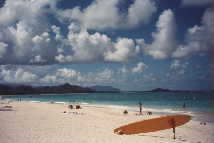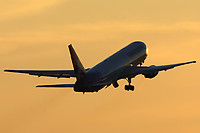
This morning I went for a swim in the ocean - I am finding that the sting of the saltwater helps clear my blocked sinuses, at least temporarily. As I luxuriated in the clear blue waters washing up on a white sandy beach, I thought about the evil oily blight currently afflicting the San Francisco Bay.
I first became aware of it last Friday when my friend Paul Nordquist from the South End Rowing Club (located by Fisherman's Wharf in downtown SF) wrote to say they can't row on the Bay at the moment because of an oil spill.
Then this morning David Helvarg, president of the Blue Frontier Campaign, emailed me a link to this article he wrote for the Los Angeles Times.
As he says at the end of his article - we all need to do something. The question is: what? A good place to start is with David's upbeat book, 50 Ways to Save the Ocean.
I am looking at how I can do more. I want to move from my row's stated goal of 'raising awareness' of the ocean crisis to doing something tangible and measurable (back to the SMART criteria again). Securing corporate sponsorship for a beach clean-up in Hawaii maybe? Even the beaches on uninhabited islands here are sometimes afflicted by piles of trash. Or possibly figuring out a way to get the message to the coastal communities of Mexico and South America, for whom leaving rubbish on the beach and waiting for the next storm to whisk it away is a widely practiced method of waste disposal.
In the meantime, another good way to help save the oceans is to donate to the Blue Frontier Campaign, which supports grassroots (aka 'seaweed') groups in their efforts.
A fine example was set by my friend Mariya, who I am staying with here in Hawaii. She had a birthday party on Sunday and asked her guests if, rather than buying presents (thereby contributing to consumerism and damaging the environment), they would make a donation to Blue Frontier Campaign (thereby helping the environment). A useful few dollars were raised, and a great time was had by all.
[photo: Kailua Beach]
|
|

Yesterday morning, dosed to the eyeballs to mask the worst effects of my cold, I went to speak to a group of Girl Scouts in Kailua. A frighteningly long time ago, I was a Girl Guide myself (the British equivalent) and I used to love the challenge of working for badges and learning new skills.
I especially loved Guide Camp, although it usually seemed to rain and our campsite was invariably full of cowpats. It was just fun to be out of doors and living under canvas, foraging for firewood and feeling close to nature.
I eventually earned enough badges across a broad spectrum of disciplines to become a Queen's Guide, the highest award in the British Guides. Looking back, it looks like I've always been into setting a goal and working hard to make it happen...
My talk yesterday was based on the Girl Scout mission: "Girl Scouts builds girls of courage, confidence, and character who make the world a better place." It may have taken 25 years longer than expected, but I'd like to think that the Girl Guides set me on the path towards achieving those objectives, and I think that the Atlantic experience was another step in the same direction.
It struck me when I read the Scout mission that it neatly sums up the internal qualities that are needed to fulfill the external goal of making a positive impact on the world. In my 'old' life, I felt I lacked all three qualities of courage, confidence and character, so my ability to make the world a better place was very limited. I was very duty-driven and always tried to do the right thing, but I simply didn't have the inner resources. Once I took some time out to focus on myself and to develop those resources, I hugely increased my potential to (hopefully) be of service to others.
So I especially like it that the mission statement puts the inner qualities first, followed by the outwards manifestation of them - in my experience, that is the right way round.
P.S. Thanks to all who have emailed or commented welcoming me to Hawaii - and for the offers of entertainment, hospitality, etc. I would love to get to see everybody but this reconnaissance week is going to be just too short. However once I've arrived here PROPERLY - by rowboat - I plan to spend Jan-Mar 2009 in the islands, and look forward to getting to know the place and the people better then.
[photo: with the Girl Scouts. I am wearing a lei of flowers - the traditional Hawaiian gift of welcome]
|
|

Today I arrived in Hawaii, straight into the middle of my friend Mariya's all-day birthday party. She lives about four doors away from the beach, so after a few hours of festivities I felt the pull of the ocean, and excused myself for a solitary walk along the beach in the dark.
I took my shoes off and let the sand and surf explore the spaces between my toes. It felt good to walk along in the strong briny breeze, listening to the ocean surge and swell - the ocean that by now I had expected to have spent about 3 months in crossing, from California to here.
I am looking forward to the coming week, and learning more about the Hawaiian ocean culture. If anything this will strengthen my already-strong resolve to continue the pursuit of my dream - and next year I will try again to get here the "right" way: by rowboat.
|
|

As I sit here in the airport, waiting to board my flight to Hawaii, I am thinking about the environmental cost of my journey. I went to the Climate Care website to calculate the associated emissions. It tells me:
The total mileage flown is 5,348 Miles (for the return flight)
The resulting emissions are: 1.19 Tonnes of CO2
The cost to offset this CO2 will be £8.91
Interestingly, to travel the same distance by car gives the result:
Your emissions from this car are 2.81 Tonnes
The cost to offset this CO2 will be £21.06
This really surprised me, as the generally received wisdom is that air travel is substantially more damaging - or does this relate more to short-hop flights? Does it make a difference how full the flight is?
If I had managed to get to Hawaii this year by means of my original choice of transport - ocean rowboat - I would be interested to know what the environmental impact of that would have been. One friend, renowned for making controversial and politically incorrect pronouncements, suggested that my impact would actually be greater, because of all the extra food that I would need to eat to power my voyage - plus the carbon produced in the manufacture of my boat and all its equipment, and possibly the airmiles required to transport some of those items to the US.
This calculation is rather beyond the capabilities of the Carbon Calculator on the Climate Care site, but my feeling is that surely the row has to be lower impact. Even if the difference in marginal, hopefully by setting an example of environmental awareness, my voyage will have a positive impact overall.
But this is a difficult area - there is so much information and misinformation. If anybody can point me in the direction of an authoritative statement on carbon emissions of various forms of transport, I would be very interested.
Oops, better run. Time to catch my flight or else all this analysis will be purely academic!
P.S. Am taking Airborne vitamin C drink and Zicam with me to help combat the cold.
|
|